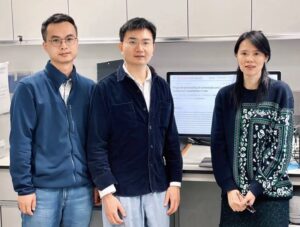CUHK
News Centre
Can animals count? Neuroscientists at CUHK and CityUHK resolve long-standing debate
Research co-led by neuroscientists Professor Ke Ya at The Chinese University of Hong Kong’s (CUHK) Faculty of Medicine (CU Medicine) and Professor Yung Wing-ho at City University of Hong Kong (CityUHK) has made a groundbreaking discovery regarding number sense in animals by confirming the existence of discrete number sense in rats, offering a crucial animal model for investigating the neural basis of numerical ability and disability in humans.
The research team has developed an innovative approach that employs a novel numerical learning task, brain manipulation techniques and artificial intelligence modelling, and that resolves an ongoing argument about whether rats have a sense of numbers. The study sheds light on the mechanisms underlying numerical ability. The findings have been published in the renowned multidisciplinary scientific journal Science Advances.
Number sense closely linked to survival and intelligence
Number sense is a fundamental ability in animals’ perception of the world and increases their chances of survival. It is also an important cognitive ability, which is fundamental to mathematical aptitude, a hallmark of human intelligence. About 3% to 7% of people suffer from dyscalculia, a learning disability that affects the ability to learn arithmetic and mathematics of people of normal intelligence; a deficit in number sense is one of the major symptoms.
Number sense refers to the capability to compare, estimate and manipulate nonsymbolic numerical quantities, rather than associated magnitudes, which are continuous dimensions inherent in a group of items, such as the area of visual objects or the duration of sound pulses. There have been challenges regarding whether number sense can be assessed in isolation from the influence of continuous magnitudes. Also, there has been a vivid ongoing debate regarding whether the sense of magnitude or the sense of number is more fundamental.
Study confirms that the rat brain has a specific area for dealing with numbers
The research team minimised the influence of continuous magnitudes in numerical tests and conducted meticulous quantitative analyses in the study to determine the respective contributions of numbers and magnitudes. They developed an algorithm to generate stimuli that enable animals to focus only on numbers, minimising other distracting factors. This will help scientists better understand how animals perceive and quantify numbers.
The study found that rats without any previous knowledge of numbers were able to develop a sense of numbers when trained with sounds representing two or three numbers. Despite the influence of continuous magnitudes, the rats consistently focused on the number of sounds when making choices for food rewards.
Professor Yung Wing-ho, Associate Dean of the Jockey Club College of Veterinary Medicine and Life Sciences and Chair Professor of Cognitive Neuroscience at CityUHK, said, “Our study helps dissect the relationship between magnitude and numerosity processing. We discovered that when we blocked a specific part of the rats’ brain, called the posterior parietal cortex, their ability to understand numbers was affected but not their sense of magnitude. This suggests that the brain has a specific area for dealing with numbers. In fact, this is the first time scientists have demonstrated that rats have the ability to discriminate and categorise three different numbers in a single test, surpassing a simple quantity comparison.”
Professor Ke Ya from the School of Biomedical Sciences at CU Medicine expressed excitement about the findings. “The study not only solves a long-standing mystery about how brains handle numbers, but also offers new insights into studying the specific neural circuits involved in number processing in animals and how genes are associated with mathematical ability,” she said. “Furthermore, the findings from neural network modelling could have practical applications in the field of artificial intelligence. In the future, our increased understanding of the brain mechanisms underlying the processing of numbers may contribute to the development of interventions for individuals with numerical difficulties.”
Professor Yung Wing-ho and Professor Ke Ya are the corresponding authors. Other contributing authors include Dr Liang Tuo, Dr Peng Rongchao, Mr Rong Kanglin and Ms Li Jiaxin from CUHK.







